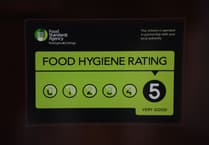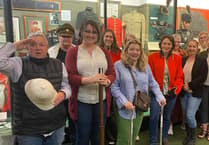A Brecon metal detectorist's discovery of a 17th century coin has won two prestigious national awards.
David Hingley, Chairman of Brecon Metal Detecting Club (MDC), was detecting on a regular permission in Monmouthshire when he dug up an Irish silver three pence known as 'Ormonde Siege money'.
The coin subsequently was named the Most Significant coin find in Wales and overall winner of all nations, by The Searcher magazine, in partnership with the British Museum for 2022.
Since 2005, the magazine has held a ‘Nations Greatest Finds Competition’ to select the most significant finds found through metal detecting and recorded through the Portable Antiquities Scheme (PAS).
The entries are chosen by Finds Liaison Officers and Advisors, Curators, Head of PAS and Treasure and not by individual detectorists, but all must be recorded with PAS.
The nominations in Wales had been selected by the PAS Cymru team and Alastair Willis (Numismatist at Amgueddfa Cymru – Museum Wales).
"When Mark Lodwick - who worked for PAS Cymru - informed me that they had entered a coin found by myself into the competition and that it had won, I was very excited," said David.
"I'm very appreciative of PAS Cymru for entering it and The Searcher magazine for organising the event."
David discovered the coin during Brecon MDC's weekend camp in 2022.
"It was Saturday morning and a few of us - still hungover from a heavy and late-night drinking session - made ready for a day's detecting,” he said.
“The ground was like concrete, I was thankful that I had brought my trusted friend of many years; a stainless-steel garden border spade sharpened to a point, though I still had to jump onto it to penetrate the baked crust."
It had been an unsuccessful day of digging for the group of detectorists, who enjoy friendly rivalry, and David had also been trying to stay out of the way of some inquisitive bullocks while on the search.
"I was about to call it a day, when my equinox 800 indicated another target to dig," he said.
"As I was cutting the clod, I left a hinge so as not to kill the grass. The depth of the hole was approximately eight inches, using my spade I hacked out more soil, scanning each new clump with the coil. It can be a slow process if you cannot find the target, especially if it is small, that's when I start using my handheld probe.
"It's at times like this you must be mindful of where you think to the target is, it is so easy to damage the coin or artefact with a spade especially in conditions where the ground is baked. Fortunately, the target was now out, so sweeping the probe over the pile of soil, I found a very small silver coin tarnished with brown stain.
"It looked unusual for a silver threepence as it had roman numerals instead of the usual number three."
The coin was issued between 1643 and 1644 by James 1, Earl of Ormonde to pay his 4,000 royalist troops, loyal to Charles I, during the Irish rebellion and the English Civil War.
David has been a detectorist for 17 years and has shared some advice for new detectorists.
"If as a new detectorist you are unsure of what you may have detected, no matter what it is there is a wealth of information out there,” he said.
“Online detecting groups all inviting you to post pictures, there is usually somebody who will advise and identify your find for you or purchase metal detecting finds books and research it. More importantly ‘record your finds through PAS’.”
"New detectorists should familiarise themselves with the current Treasure Act and responsible detecting code of practice, all of which are available on the internet," he added.





Comments
This article has no comments yet. Be the first to leave a comment.